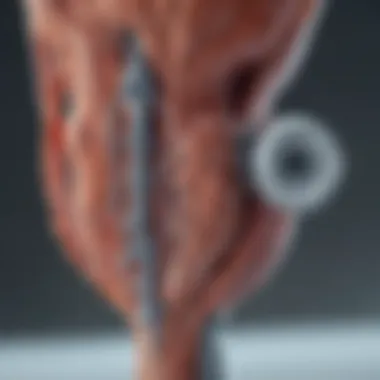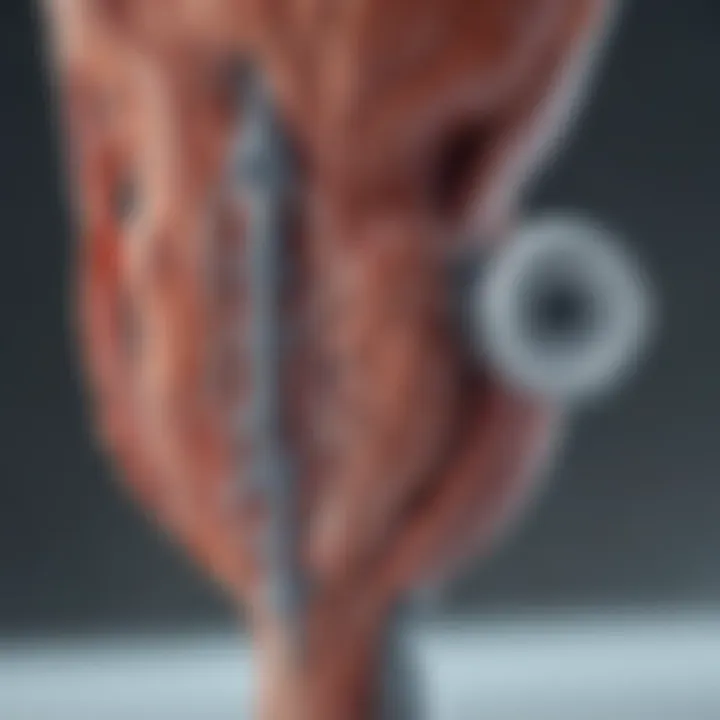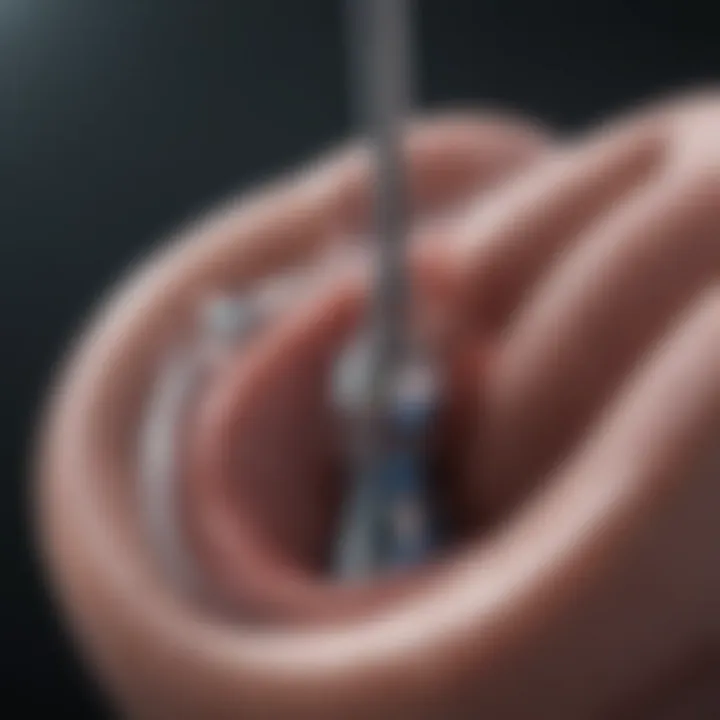Bladder Implants: Mechanisms and Future Trends


Intro
The realm of bladder health presents a myriad of challenges, often leading to conditions requiring surgical solutions. Bladder implants, in particular, have gained prominence, underscoring the need to dive deeper into their mechanisms, applications, and new developments. As individuals facing complications such as incontinence or bladder infrastructure issues seek options, understanding how these implants function and their impact on patient lives becomes crucial.
With cutting-edge technologies emerging in the medical field, exploring bladder implants reveals a dynamic intersection of urology, materials science, and innovative surgical practices. In this article, we will navigate the landscape of bladder implants to enlighten readers—from students and healthcare professionals to seasoned researchers—on the current state and future potential of these medical advancements.
Research Overview
Understanding bladder implants necessitates a careful examination of various aspects, from the underlying conditions that prompt surgical intervention to the types of implants currently available in medical practice.
Methodological Approaches
Research into bladder implants often incorporates a mix of clinical studies, patient surveys, and materials testing. For instance, many studies measure patient outcomes post-surgery to gauge the effectiveness of particular implant types. Outcomes such as reduced complication rates, improved quality of life, and patient satisfaction are frequently quantified using standardized questionnaires. Moreover, collaboration between urologists and material scientists fosters deeper understanding of how different materials interact within the human body.
It's common to analyze performance metrics through randomized controlled trials, offering rigorous evidence that shapes the direction of therapy. Furthermore, advancements in imaging techniques allow for pre-operative planning and precise implant placement, enhancing surgical success rates.
Significance and Implications
The implications of research in bladder implants reach far beyond individual health. They touch on healthcare systems, economic factors, and patient autonomy. Emerging evidence suggests that improved implant technologies and surgical techniques can lead to shorter recovery times, thereby reducing hospital stays and associated costs. Additionally, with an aging population and rising incidences of related disorders, understanding and optimizing bladder interventions is becoming increasingly important.
"Innovations in bladder implant technology can transform the lives of thousands, enabling better management of bladder health without compromising quality of life."
Current Trends in Science
In the ever-evolving field of medical technology, bladder implants represent a lively area of innovation, with trends that reflect broader scientific discoveries and needs.
Innovative Techniques and Tools
One notable trend in the field is the utilization of biocompatible materials that integrate smoothly with human tissue. Research has shifted towards creating implants that not only serve structural purposes but can also promote tissue regeneration. For example, bioengineered scaffolding systems may aid healing, potentially leading to enhanced patient outcomes. Furthermore, minimally invasive surgical techniques, aided by robotic assistance, are proving to be game changers, resulting in reduced recovery times and lower rates of complications post-surgery.
Interdisciplinary Connections
The study and application of bladder implants extend into various fields such as biomedical engineering, materials science, and even robotics. For example, the intersection of urology and engineering fosters the development of smart implants that can monitor bladder pressure and send alerts in real-time, paving the way for personalized patient management. As these domains collaborate, we witness an exciting synergy that drives research forward, pushing the boundaries of what's achievable in urological health.
In summary, by crafting a comprehensive understanding of bladder implants through innovative research and clinical applications, we can better address the urgent needs of patients while simultaneously paving the way for future advancements in the field.
Prelude to Bladder Implants
Bladder implants have become a focal point in the field of urology, offering renewed hope for patients dealing with a variety of bladder disorders. While the subject may appear technical at first glance, understanding the context behind these implants provides significant insight into their role in enhancing quality of life. The importance of this topic lies in its ability to highlight the solid link between bladder health and overall well-being. This examination not only delves into mechanisms of bladder implants but also explores their applications, and future research directions that promise better patient outcomes.
The bladder is a complex organ, essential for storing and expelling urine. Its anatomy demands a precise understanding because various conditions may impede its functionality. Particularly prevalent conditions, such as Overactive Bladder, Bladder Cancer, and Neurogenic Bladder, highlight the real-world relevance of bladder implants. The necessity for intervention arises when non-invasive treatments fail, and patients seek alternatives that could restore normalcy to their lives.
Through the lens of this discussion, we will guide readers on a journey from understanding bladder anatomy to detailing how various types of implants serve specific needs. Apart from mechanical solutions, the article will embody an awareness of the emotional and psychological aspect of living with bladder conditions. Navigating these nuances ensures a holistic understanding of the topic.
As we transition through various subsections, emphasis will be laid on mechanisms of bladder implants, the surgical procedures that facilitate their placement, and the valuable insights gained from patient outcomes. The narrative aims to foster a deeper understanding of why these implants are not merely clinical choices but pivotal elements in restoring dignity and functionality to patients’ lives.
Types of Bladder Implants
Understanding the variety of bladder implants available today is crucial for both medical professionals and patients navigating treatment options. Each type of implant presents unique benefits, considerations, and potential outcomes. This section will delve into the three primary categories of bladder implants: Synthetic Bladder Mesh, Biocompatible Tissue Implants, and Autologous Bladder Tissue Techniques. By dissecting these options, we can better grasp how they fit into overall treatment strategies for bladder-related conditions.
Synthetic Bladder Mesh
Synthetic bladder mesh is a popular choice in urological surgeries aimed at treating bladder disorders. These implants, usually made from materials such as polypropylene, are designed to provide structural support to the bladder. One clear advantage is their durability, which can be beneficial in long-term rehabilitation for patients suffering from conditions like incontinence.
However, the use of synthetic materials isn't without risks. The body’s response to these meshes can vary; some patients may develop complications like erosion into neighboring organs or chronic pain. Understanding patient history and conducting thorough preoperative assessments is essential when opting for this option.
- Key Benefits:
- Considerations:
- High durability
- Effective support
- Potential for erosion
- Risk of chronic pain
"Choosing the right implant is a balancing act between benefits and potential complications. Careful consideration and patient-specific factors must guide the decision-making process."


Biocompatible Tissue Implants
Biocompatible tissue implants are often made of materials that are designed to work harmoniously with the human body. These implants aim to minimize adverse reactions while providing the necessary support for the bladder. The appeal of biocompatibility lies in its potential for integration into the body without triggering significant rejection responses.
An example includes materials derived from human or animal tissues, which can foster healing and regeneration. Such implants may be particularly useful for patients with a history of complications from synthetic materials. However, the biological variability should be understood; different patients’ responses to these materials can fluctuate.
- Key Benefits:
- Considerations:
- Reduced rejection risks
- Promotes healing
- Biological variability
- Possible longer-term performance issues
Autologous Bladder Tissue Techniques
Autologous bladder tissue techniques are perhaps the most innovative approach in bladder reconstruction. In these procedures, a patient's own tissue is harvested and used to create or reinforce the bladder. The primary advantage here is the high compatibility; since the tissue is sourced from the patient, the chances of rejection or adverse reactions are significantly lower.
This method can be particularly beneficial in cases where other implants have failed or where chronic conditions necessitate a more personalized solution. However, these techniques often require more extensive surgical procedures and longer recovery times, which need to be carefully weighed against their benefits.
- Key Benefits:
- Considerations:
- High compatibility
- Lower rejection risks
- Extensive surgical procedure
- Potential for longer recovery period
Each type of implant presents its strengths and weaknesses, illustrating the importance of selecting the appropriate method based on individual circumstances. As technology advances, the landscape for bladder implants continues to evolve, ensuring a tailored approach for each patient's needs.
Surgical Procedures Involved in Bladder Implantation
Surgical procedures related to bladder implantation are a crucial aspect of addressing various bladder conditions. They not only pave the way for improved patient outcomes but also help in restoring the quality of life. Understanding these procedures is vital for healthcare professionals, patients, and researchers alike. The techniques employed in bladder implant surgeries significantly influence the success rates and overall satisfaction levels after the procedure. Additionally, assessing the postoperative care and management is essential to ensure long-term benefits and minimize complications.
Preoperative Assessment
Before any surgical intervention, a thorough preoperative assessment is essential. This assessment typically includes a comprehensive evaluation of the patient's medical history and a physical examination. Health professionals look particularly at:
- Underlying health conditions: Existing diseases can complicate surgical processes or recovery.
- Medication review: Certain medications may need to be adjusted prior to surgery to prevent bleeding or adverse reactions.
- Diagnostic imaging: Such as ultrasound or MRI, helps visualize the bladder and assess any anatomical abnormalities.
- Urodynamic testing: To measure how well the bladder and urethra store and release urine, providing insight on the best surgical approach.
An effective preoperative assessment ensures that the surgical team is fully prepared and that the patient is informed about what to expect. This not only helps in surgical planning but also fosters a smoother recovery process.
Surgical Techniques for Implant Placement
When it comes to surgical techniques employed in bladder implantation, two primary methods are commonly used: Robotic-Assisted Surgery and Traditional Laparoscopic Methods. Each option has its merits and potential risks, thus requiring careful consideration based on individual patient needs.
Robotic-Assisted Surgery
Robotic-Assisted Surgery has gained popularity in recent years, primarily because it offers enhanced precision. The unique advantage of robotic systems is their ability to facilitate intricate maneuvers that may be challenging through traditional techniques. Surgeons operate through tiny incisions while controlling robotic arms from a console, resulting in minimally invasive procedures with less postoperative pain.
Key characteristics of Robotic-Assisted Surgery include:
- High-definition 3D visualization: It provides surgeons with a clearer view of complex anatomical structures.
- Articulating instruments: This allows for greater flexibility and precision compared to standard laparoscopic tools.
Despite these benefits, this technique can be expensive and may require a longer setup time. So, for some patients, traditional methods could be more practical.
Traditional Laparoscopic Methods
Traditional Laparoscopic Methods have been the gold standard for a lengthy period and continue to be a favored choice for many surgeries. This approach relies on the use of long, thin instruments inserted through small incisions in the abdomen.
A significant benefit of these methods is their established track record. They are less costly than robotic-assisted procedures, making them more accessible for patients. The speed of surgery is also a notable element—surgeons are often able to complete the procedure relatively quickly.
Unique features of Traditional Laparoscopic Methods include:
- Established protocols: Many surgeons are trained extensively in these techniques.
- Lower costs: Less expensive instruments and no need for robotic systems reduce overall procedure costs.
Yet, these methods can come with downsides, such as a steeper learning curve for more complicated cases and possibly less precision compared to robotic procedures.
Postoperative Care


Following bladder implantation, the final key component of the surgical journey is postoperative care. This includes monitoring for any complications, managing pain, and ensuring proper healing. Elements of effective postoperative care comprise:
- Routine follow-ups: Regular check-ups help in evaluating recovery progress and addressing any concerns promptly.
- Pain management protocols: Effective pain relief strategies can aid recovery and improve overall patient satisfaction.
- Patient education: Instructing patients on self-care techniques and signs of complications is pivotal in fostering a positive recovery experience.
Appropriately managed postoperative care not only promotes healing but also enhances the chances of successful long-term outcomes in bladder implant patients.
Patient Outcomes and Quality of Life
Understanding the impact of bladder implants on patient outcomes and quality of life is crucial for anyone involved in urological care, be it healthcare practitioners or patients themselves. With bladder conditions often leading to debilitating issues such as incontinence, frequent urination, or pain, the effectiveness of these implants plays a significant role. The purpose of implants is not just to resolve these physical issues, but also to significantly improve the overall well-being of the patient, enabling a more active and fulfilling life.
Success Rates of Bladder Implants
The success rates of bladder implants can often dictate the chances of patients regaining a normal lifestyle post-surgery. Success, in this context, usually refers to the absence of the original symptoms, or at least a significant decrease in their severity. Recent studies have shown that synthetic bladder mesh implants have a reported success rate of around 70% to 90% depending on various factors such as the type of bladder condition and the surgical technique used. This varies widely, however, based on individual patient circumstances, such as age, overall health, and adherence to postoperative care.
The metrics for success also encompass complications that may arise. It’s noted that, while complications are not common, about 5% to 10% of patients may experience erosion or migration of the implant, which can necessitate further surgical intervention. In consideration of success, it is essential to evaluate not only symptom relief but also these risks:
- Infection: Development of infections post-surgery, which can complicate recovery.
- Chronic Pain: Some may experience ongoing discomfort, affecting overall happiness.
- Functional Change: Introduction of new symptoms or adjustments needed for everyday life.
Patient Satisfaction and Quality of Life Assessments
The assessment of patient satisfaction post-implantation is often the crux of gauging quality of life improvements. This involves exploring how the surgical intervention has transformed their daily existence. Various standardized questionnaires have been developed to comprehensively assess this satisfaction, such as the Overactive Bladder Questionnaire (OAB-q) or the Patient Global Impression of Improvement (PGI-I). These tools focus on areas such as:
- Symptom Control: Evaluating how well bladder function has improved since the surgery.
- Daily Activities: Understanding how surgical success has influenced routine tasks, from work to social gatherings.
- Emotional Well-Being: Recognizing the psychological aspects; feeling confident and not being hindered by bladder issues can dramatically uplift a person's spirit.
Research has shown that those with successful outcomes report a noticeable increase in their quality of life. Many patients express that their satisfaction stems not just from the physical relief from symptoms but also from a renewed sense of independence and participation in life’s experiences.
"Satisfaction isn't just about the absence of problems, it’s about gaining back what was once lost in one's everyday life."
As patient satisfaction continues to be a vital metric, ongoing research aims to enhance procedures and materials used in bladder implants, further tailoring treatments to individual patient needs. This continuous evolution is key to refining the journey of recovery and ensuring that bladder implants serve their purpose effectively, maximizing benefits to current and future patients.
Potential Complications and Risks
The incorporation of bladder implants can dramatically improve the quality of life for patients with various urological conditions. However, it's critical to understand that these implants come with potential complications and risks. This section explores the importance of these concerns, shedding light on specific factors that healthcare professionals, patients, and researchers must consider when approaching bladder implant surgeries. Recognizing these risks not only aids in better surgical planning but also enhances patient education and post-operative care.
Infection and Inflammation
One of the initial concerns with bladder implants is the risk of infection and subsequent inflammation. After the implantation procedure, there’s always a likelihood that pathogens can enter the surgical site, leading to complications such as urinary tract infections or even more severe systemic infections.
- Symptoms: Common signs of infection may include increased pain, fever, or unusual discharge.
- Preventative measures: Surgeons usually prescribe antibiotics post-surgery to mitigate these risks, alongside thorough preoperative assessments to identify any existing infection.
Moreover, inflammation around the implant can occur as a part of the body's natural healing response. While some inflammation is expected, excessive inflammation can cause discomfort and even implant failure.
"Vigilance in monitoring post-surgical symptoms can mean the difference between a quick recovery and prolonged complications."
Erosion and Migration of Implants
Erosion represents another serious risk associated with bladder implants. Over time, the implant may begin to erode into surrounding tissues. This can lead to pain and additional complications, such as urinary leakage. It's a complex situation that can arise from various factors:
- Material composition: Some synthetic materials may not tolerate the body's environment, leading to an increased likelihood of erosion.
- Improper placement: If the implant isn’t positioned correctly during surgery, it can shift over time, increasing the risk of erosion.
Migration of the implant, similar to erosion, occurs when the implant shifts from its original site, which can cause further complications such as obstruction or irritation. Regular follow-ups are vital in monitoring the positioning of the implant and preventing these issues.
Chronic Pain Syndromes
Chronic pain syndromes are another potential long-term consequence for patients with bladder implants. A variety of factors may contribute to this persistent discomfort, including:
- Nerve Damage: Surgical procedures carry the risk of damage to surrounding nerves, leading to ongoing pain.
- Scar Tissue Formation: Healing processes can sometimes result in excess scar tissue, which may cause discomfort or restrict bladder function.
- Psychosomatic Factors: Chronic pain can also stem from emotional or psychological stress, complicating recovery and quality of life.
It is essential for healthcare providers to address these potential issues with patients during preoperative consultations and offer comprehensive pain management strategies post-surgery. Regular evaluations and open communication can significantly aid in alleviating chronic pain syndromes, enhancing the overall experience and recovery for those involved.
Advancements in Bladder Implant Technology
The landscape of medical treatments is ever-evolving, and bladder implants are no exception. Advancements in bladder implant technology bear significant promise—not only in improving patient outcomes but also in enhancing the quality of life for those suffering from chronic bladder conditions. As the field moves forward, tapping into new materials and techniques will allow for more effective, personalized solutions.
Innovative Materials for Bladder Implants


When it comes to bladder implants, the material used is of utmost importance. Traditional implants often utilized materials that may not fuse well with the body or, even worse, provoke adverse reactions. However, recent innovations are steering the ship in the right direction.
Biocompatible Polymers
Many new implants now utilize biocompatible polymers, which promise a lower risk of inflammation and other complications. These materials are designed to integrate seamlessly with bodily tissues, creating a more robust union. For instance, polyvinylidene fluoride (PVDF) is showing promise due to its ability to resist chemical degradation while maintaining flexibility, which is crucial for bladder function.
"The right materials can mean the difference between a successful procedure and one fraught with complications."
Natural Products
Moreover, there is a growing trend toward using natural products in the fabrication of implants. Materials derived from collagen or fibrin can be tailored to mimic the natural environment of the bladder. This not only aids in healing but also reduces the chances of rejection, allowing the implant to function efficiently over time.
Bioprinting and Regenerative Medicine
Bioprinting represents a groundbreaking advancement in the field of bladder implants, pushing the envelope on what is possible in regenerative medicine. This innovative technology enables the precise layering of cells and biomaterials to create structures that can mimic the complexity of natural organs.
Tailored Solutions
Through bioprinting, it is possible to customize bladder implants on a patient-by-patient basis. This level of personalization ensures that the shape, size, and even functional characteristics of the implants match the patient's unique bladder morphology. The use of stem cells in bioprinting also provides the capability to regenerate bladder tissues, potentially alleviating some of the need for synthetic implants altogether.
Ongoing Research and Challenges
Though the future appears promising, challenges remain. Navigating regulatory hurdles and ensuring the long-term viability of bioprinted implants are tasks that the medical community must address. Continuous refinement of techniques and materials will be crucial for overcoming these obstacles and realizing the full potential of bioprinting in bladder care.
In summary, advancements in bladder implant technology hinge on innovative materials and cutting-edge techniques. By focusing on biocompatibility and leveraging modern practices like bioprinting, researchers and clinicians are on the cusp of a revolution in the management of bladder-related diseases.
Future Directions in Bladder Implant Research
The future of bladder implant research holds significant promise, paving the way for enhanced patient outcomes and a more refined understanding of bladder pathology. Continuous breakthroughs in technology and scientific understanding are set to transform the landscape of urologic health. For both practitioners and patients, these developments are more than just fanciful ideas; they represent a shift toward more personalized and efficient treatment options.
Integrating AI in Surgical Planning
Artificial Intelligence is becoming a game-changer in many medical fields, and bladder implant surgery is no exception. Utilizing AI in surgical planning can help streamline processes, improve accuracy, and reduce the likelihood of complications.
- Enhanced Preoperative Assessment: AI algorithms can analyze a multitude of data points from patients, including medical history, imaging, and existing health conditions. This comprehensive analysis can assist surgeons in better planning their approach, potentially leading to improved surgical outcomes.
- Predictive Analytics: Machine learning models can be trained to predict complications based on historical data from similar procedures. Surgeons can use this information to tailor their techniques more effectively, anticipating challenges and adapting accordingly.
- Surgical Navigation: With the integration of AI, robotic-assisted surgical systems can provide real-time data during surgeries. This means surgeons can have critical feedback and adjust their techniques on the fly, thus improving precision in placement and potentially shortening recovery times for patients.
"Integrating AI into bladder implant surgery could lead to a precision that has been beyond our reach, reducing variation in outcomes and increasing patient safety."
The Potential of Stem Cell Therapy
Stem cell therapy has been gaining traction as a revolutionary approach in the realm of regenerative medicine, especially concerning bladder health. This innovative therapy may provide a solution for complications arising from traditional bladder implants.
- Regenerative Properties: Stem cells possess unique regenerative capabilities, making them a candidate for repairing bladder tissue or replacing damaged segments. This could ultimately reduce the need for implants in specific cases.
- Personalized Treatment: By utilizing a patient's own stem cells, healthcare providers can develop personalized treatments that minimize the risk of rejection or adverse reactions, enhancing the overall success rates of bladder interventions.
- Potential to Address Chronic Conditions: Stem cell therapy holds potential not just for repair, but also for managing chronic bladder conditions. Research is underway to understand how stem cell applications could mitigate issues associated with overactive or neurogenic bladders.
In summary, the future trajectories of bladder implant research are filled with exciting possibilities. By harnessing the power of AI for surgical planning and exploring the regenerative potential of stem cell therapy, healthcare is swiftly moving towards a more individualized and effective approach. As these methods evolve, they promise to transform the lives of patients, affording them renewed hope and improved quality of life.
Closure
The importance of the conclusion in this article cannot be overstated. It serves as the culmination of a comprehensive examination of bladder implants, integrating the various threads woven throughout the previous sections. This section is where we distill the myriad insights into digestible key points, ensuring that readers leave with a clear understanding of the significance of bladder implants in medical practice.
The landscape of bladder implants is constantly evolving, and recognizing key insights helps frame the gradually changing paradigms in urology. The examination of prevalent conditions such as overactive bladder, bladder cancer, and neurogenic issues illustrates the array of challenges these implants address. Furthermore, discussing types like synthetic meshes and autologous tissue techniques highlights the diversity and adaptability of modern surgical solutions.
Another critical element in the conclusion is the acknowledgment of patient outcomes and quality of life assessments. As surgical techniques advance, the focus remains squarely on improving patient satisfaction and mitigating complications. Therefore, summarizing success rates and detailing complications, such as infection or erosion, reaffirms the necessity for ongoing vigilance and adaptation in clinical practices.
“Understanding the multifaceted role of bladder implants enables healthcare professionals to make informed decisions, ultimately benefiting patient care.”
In ponderance of future directions, one sees not only the promise of technological innovations but also the pressing need for further research initiatives. By integrating new materials and relentlessly pursuing advancements, the field stands at the forefront of creating more effective and safer solutions for individuals affected by bladder conditions.
Summarizing Key Insights
In reviewing the key insights gathered from this article, we note several pivotal takeaways:
- Diverse Applications: Bladder implants cater to various urological conditions, thereby enhancing treatment regimens tailored to individual patient needs.
- Surgical Techniques: The operational landscape encompasses both traditional and robotic-assisted methods, reflecting a critical trend towards patient-centric and minimally invasive procedures.
- Patient-Centric Outcomes: Measuring success transcends surgical metrics and includes evaluating overall quality of life for patients following implantation.
- Technological Advances: Continuous innovations such as bioprinting and smarter materials are paving the way for a new era in urological healthcare.
Encouraging Future Research Efforts
Looking ahead, fostering research endeavors in bladder implants is paramount. Areas where further exploration could yield significant benefits include:
- Interdisciplinary Approaches: Collaboration among engineers, biologists, and clinicians can drive the discovery of novel materials and enhanced surgical techniques.
- Longitudinal Studies: Continuous follow-up and long-term studies will provide insights into the lasting impacts of various implant strategies on patient outcomes.
- Patient Education: Focusing on improving patient understanding of their conditions and implant options is essential. Informing patients about potential risks and benefits empowers them in their healthcare journeys.
- Regenerative Medicine: Continued exploration of stem cell therapies holds promise for the future of bladder treatment, potentially revolutionizing existing methodologies.
By emphasizing these areas as avenues for future research, we can ensure that the bladder implant domain remains dynamic and responsive to the needs of patients and healthcare practitioners alike.



